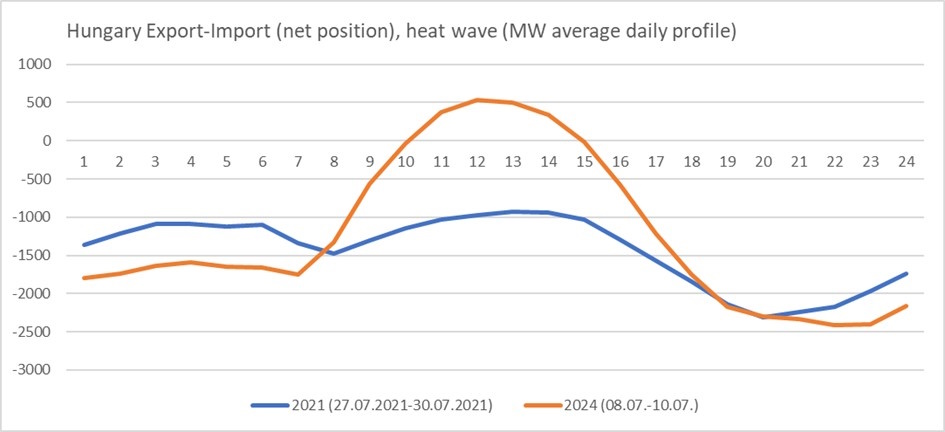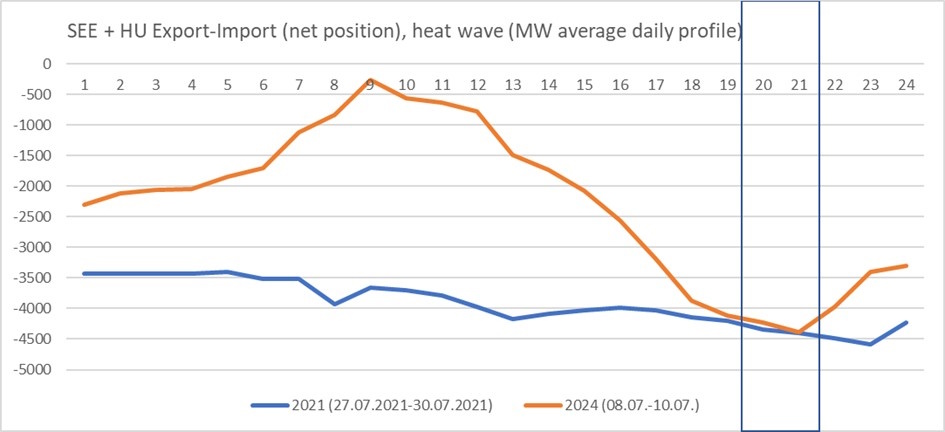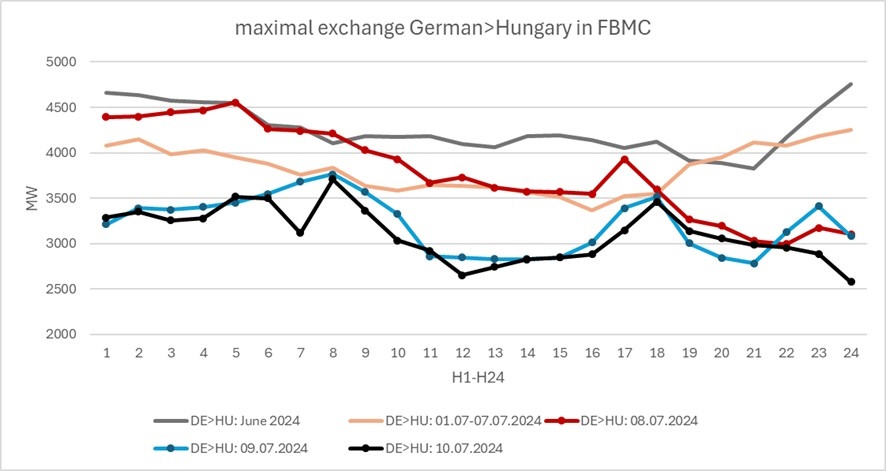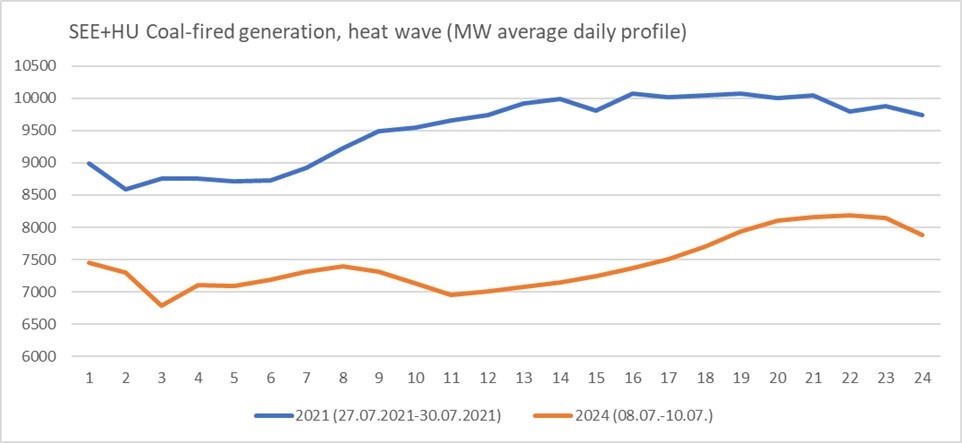
Foto: PixelAnarchy from Pixabay
Record high temperatures across Southeast Europe, reaching 40 degrees Celsius for several days in a row, bolstered electricity consumption. But according to experts, it isn’t the main cause of the unseen price increase on power exchanges so far, by 50% to 170%. Some of the main factors are the reduction of transmission capacities between Hungary and the rest of the European Union, with Serbia as well, and between Bulgaria and Romania. There is also a delay in the return of the Kozloduy nuclear plant to the entire operation, together with the reduction in output from coal-fired power plants and Ukraine’s switch from being an exporter to an importer.
The highest price jump was registered on the Hungarian power exchange, HUPX, for deliveries between 20:00 and 23:00. The level reached an astonishing EUR 940 per MWh, compared to around EUR 350 the previous week. This week, the average price on the day-ahead market (DAM) is EUR 200 per MWh, compared to EUR 120 per MWh in the previous seven-day period. Such high levels have not been seen since 2022 during the energy crisis.
Romania’s OPCOM had the maximum hourly DAM prices, reaching EUR 700 per MWh, doubling from the previous week. The Bulgarian IBEX hit EUR 500 per MWh after EUR 365 per MWh in the last equivalent period. The wave quickly hit Greece, Croatia, and Serbia.
In Croatia, the CROPEX benchmark showed EUR 390 per MWh, while at Serbia’s SEEPEX, the level exceeded EUR 400 per MWh. Last week, the maximum price was EUR 125 per MWh. There is little possibility of a letdown because the heatwave is forecasted to continue, and the factors propping up prices are about to stay the same.
Kosorić: Many factors driving price surge – some are obvious, others not
Marko Kosorić, SEE Energy Business Expert at Balkan Energy AG, says that the analysis demonstrated that the price spike is a consequence of many factors, some obvious and others not.
“Even though most markets registered extreme prices, the one in Hungary surprised the most. High prices can only partially be explained by a rise in imports amid the heatwave,” he told Balkan Green Energy News.
He said the heatwave between July 8 and 10 is comparable to July 27 to 30, 2021, when temperatures were similar.
“It is true that the average price on HUPX was extremely high, but mostly because of just two hours, 20h and 21h. Did those hours cause stress, given the size of imports into Hungary alone? The electricity imports into Hungary in 20h and 21h were not higher than during the heatwave of July 2021. Therefore, the Hungarian market doesn’t import more than before, but the prices are much higher than in similar conditions during the 2021 heatwave,” Kosorić stressed.

The analysis shows consumption in Southeast Europe – Albania, Bosnia and Herzegovina, Bulgaria, Croatia, Greece, Hungary, Montenegro, North Macedonia, Romania, Serbia and Slovenia – isn’t much higher now than during the heatwave of July 2021. The spread doesn’t exceed 800 MW in the hours from 20h to 24h.

In both cases, the region imported power from Central-Western Europe via the Austrian-Slovenian, Austrian-Hungarian, Slovakian-Hungarian and Italian-SEE borders.
However, he explains that the total import grid could sustain in hours from 20h to 24h was 800 MW lower in 2024 than in 2021.
“This shows that the effective grid capacity from Central-Western Europe was lower than it was in 2021, and this was the most unexpected factor which happened as of July 8, fueling extreme HUPX prices,” Kosorić says and adds that the total import of the SEE region wasn’t much higher than it was during the heat wave of July 2021 – 4,400 MW.
Flow-based market coupling is key
According to the analysis, Flow-Based Market Coupling (FBCM) is “forcing” the Hungarian bidding zone to produce more energy by giving HUPX a higher price. However, it cannot produce more, irrespective of the HUPX price. FBMC doesn’t let the Hungarian market import more in the welfare optimization, Kosorić said.
The analysis showed plenty of grid capacity from Croatia and Slovenia to Hungary, but such transactions would increase Hungarian imports, which would not be favorable for welfare optimization. Namely, traders can no longer nominate energy from the Croatian to the Hungarian market, so the prices on the two markets cannot be equalized as in the net transmission capacity (NTC) coupling mechanism.
Data show that maximal FBMC bilateral flows from Europe to Hungary were significantly reduced after July 8, by 1,200 MW to 1,300 MW, in the riskiest hours from 19h to 24h.

Kosorić believed the only way to boost power flows to the Hungarian market by bypassing the FCBM mechanism was via the Serbian-Hungarian border. Still, the link NTC was slashed from 800 MW to 200 MW.
The other options are increasing the FBMC capacity, though Kosorić points out there is no timeline for it, and cutting exports to Ukraine from Hungary and Romania.
Transmission grid constraints in the region were also higher this year than in 2021, and grid capacity was more limited. The maximum Bulgaria-Romania cross-border capacity was weakened to 1,200 MW from 1,700 MW due to maintenance scheduled until July 22. Therefore, the Romanian market has to be supplied from the Hungarian market, but, as Kosorić put it, in a very non-intuitive way.
FBMC enables much lower prices on OPCOM than on HUPX
From 18h to 24h, all available selling offers on the Romanian market were taken, and the only solution within FBMC was to nominate a high commercial flow from Hungary to Romania.
However, it was nominated in a highly counterintuitive manner as FBMC enables much lower prices on OPCOM than on HUPX, sometimes by as much as EUR 250 per MWh, while delivering energy from HUPX to OPCOM, according to Kosorić.
In his view, FBMC sometimes results in non-intuitive flows, resulting from the coupling of markets in the direction of bidding zones with higher to ones with lower prices. Such flows, Kosorić said, usually occur when the loss of economic welfare resulting from the non-intuitive flow is smaller than the economic welfare gain of congestion relieving.
Since the Romanian bidding zone is not connected to any other core region bidding zone but the Hungarian one and congestion is not relieved with flow from Hungary to Romania since congestion is not in this direction, the reason for such non-intuitive solutions is probably the complete absence of any available offer on the Romanian market.
The non-intuitive Hungary-Romania flow is probably not a consequence of economic welfare optimization against the welfare gain that would come from the congestion relief, Kosorić explains.
Grid capacity isn’t the only issue

The issues are not limited to the transmission grid. According to the analysis, multiple factors could cause the high prices achieved at all the power exchanges.
Interestingly, imports in the region were the same as in the heatwave of 2021, but many other parameters are different. It imported electricity at 700 MW from Ukraine, but now it is exporting at 800 MW to Ukraine and Moldova.
There is now much less cheap electricity in the region from coal plants
Kosorić noted that coal power plant capacity in the region has dropped by 2,000 MW, cutting the availability of cheap electricity in the riskiest hours. The return of a 1,000 MW reactor in the Kozloduy nuclear power plant to the grid was delayed by three weeks. The synchronization began on July 8, and the unit reached full and stable production in the afternoon of July 10.
Kosorić concluded that current prices on HUPX in the hours 20h, 21h, and 22h are a consequence of the grid’s inability to deliver additional energy to Hungarian and Romanian markets physically and are not related to real energy generation costs.
He says the current prices in the hours 20h, 21h, and 22h on other markets in the region are also not a consequence of real production costs but elevated offer prices.
What to expect in the coming weeks

Kosorić doesn’t expect anything to change over the coming weeks.
“Next week will be even warmer than this one, with no other important structural changes so that the region will remain highly sensitive. Transmission grid limitations within the FBMC mechanism can get even stronger due to overhauls in Central European grids, while hydropower output is falling and solar power generation is at its maximum,” he says.


















Be the first one to comment on this article.